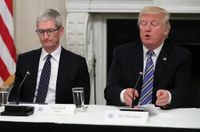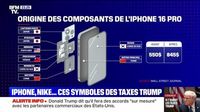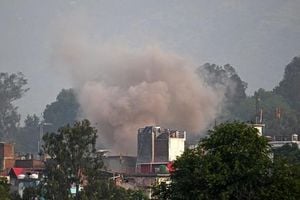As the trade war initiated by former President Donald Trump intensifies, Apple faces a potential price surge for its flagship product, the iPhone, that could leave consumers reeling. The recent announcements of steep tariffs on Chinese imports could see the price of an iPhone rise by as much as 25%, with some analysts predicting even more drastic increases.
The program "22h Max" on BFMTV on April 8, 2025, highlighted iPhone and Nike as symbols of Trump's taxation policies, showcasing how these brands are directly impacted by the economic landscape shaped by the former president's trade decisions. Perrine Storme, the show's host, summarized the day's significant events and statements, drawing attention to the implications of these tariffs on consumer electronics.
According to a report from UBS, a leading wealth management firm, the price of an iPhone, currently sold for $1,000 in the United States, could soar to over $3,000 under extreme scenarios. This alarming prediction underscores the gravity of the situation as the tech giant navigates the turbulent waters of international trade.
Apple's reliance on China is profound, with approximately 80% of its iPhone production capacity located there. The company assembles around 90% of its iPhones in China, making it particularly vulnerable to the 54% tariffs imposed on imports from the country. The impact of these tariffs is not limited to just the iPhone; other Apple products, including the Apple Watch, iPad, and AirPods, are also likely to see price increases of up to 46% due to tariffs on components sourced from Vietnam and India.
In response to the looming threat of rising prices, Apple is exploring several strategies to mitigate the financial burden on consumers. One option under consideration is relocating a significant portion of its production to India, where tariffs are comparatively lower at 26%. This move could help stabilize prices and maintain Apple's market share amidst growing competition and economic pressure.
However, the transition to Indian manufacturing is fraught with challenges. Industry experts warn that while some costs may be absorbed throughout the supply chain, consumers are unlikely to escape the impact of these tariffs entirely. Sébastien Jean, an economist at the Conservatoire national des arts et métiers, noted that Apple might separate intellectual property costs from the physical products to reduce the overall tariff burden, potentially limiting price increases to 5% to 10%.
The stakes are high for Apple, as the iPhone accounts for roughly 50% of the company's revenue. With increasing consumer anxiety over potential price hikes, sales of the iPhone have surged as customers rush to purchase devices before the tariffs take effect. Reports indicate that Apple Stores are experiencing traffic levels akin to the holiday season, with employees fielding numerous inquiries regarding price increases.
In a bid to anticipate demand, Apple is stockpiling iPhones and rerouting devices manufactured in India to the U.S. market. Despite the lower tariff rate in India, production there is still insufficient to meet the overwhelming demand from American consumers. As the company grapples with a staggering 55% increase in manufacturing costs, Apple faces a critical decision: either absorb the costs, negotiate better terms with suppliers, or pass the expenses onto consumers.
As the market adjusts to these new realities, analysts predict that the next generation of iPhones, including the anticipated iPhone 17 set for release in September, may see significant price adjustments. The uncertainty surrounding the tariffs adds an additional layer of complexity to consumer expectations and purchasing decisions.
Amidst the turmoil, the White House has expressed optimism about reviving American manufacturing capabilities. Karoline Leavitt, the White House press secretary, recently defended Trump's industrial ambitions, stating that the president believes the United States possesses the workforce and resources necessary to produce iPhones domestically. Apple has committed to investing $500 billion in the U.S. over the next four years, primarily focused on research and development, chip production, and educational programs.
However, industry insiders remain skeptical about the feasibility of large-scale iPhone production on American soil. Tim Cook, Apple's CEO, has previously remarked on the challenges of replicating the industrial ecosystem found in China, where the concentration of manufacturing expertise far exceeds what is available in the U.S.
While the notion of a "Made in America" iPhone has been floated in political circles, analysts caution that the logistical and financial hurdles are substantial. The reality is that many essential components, such as chips and screens, are sourced from Asia, and relocating assembly operations to the U.S. would only partially circumvent the tariffs.
As the situation unfolds, the pressure on Apple and other tech giants to adapt their supply chains will only increase. The company has already begun diversifying its manufacturing footprint, with increased production in India and Vietnam, but a complete return to American assembly seems unlikely in the near future.
In the meantime, consumers are left to navigate the uncertainty surrounding the future prices of their favorite devices. With the market reacting to the potential for increased costs, the coming weeks will be crucial for Apple as it attempts to balance profitability with consumer expectations in an increasingly competitive landscape.
As the trade war continues to evolve, the implications for tech companies and consumers alike remain profound. The decisions made in the coming months will undoubtedly shape the future of the American tech industry and its relationship with global markets.









